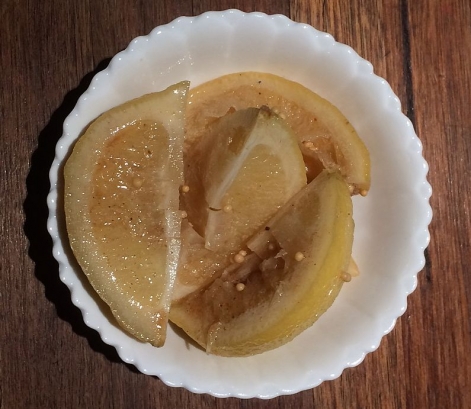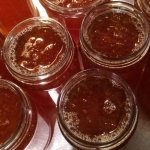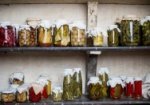As Charmaine O’Brien points out in her book The Colonial Kitchen, Margaret Pearson’s Lemon Pickle recipe reminds us that the relatively recent trend for ‘Moroccan preserved lemons’ is not new to Australian tables at all. The principle difference between the recipe published by Pearson in the 1880s and our idea of Moroccan-style lemons – such as students make in education programs at Vaucluse House – is that the colonial version uses vinegar as well as salt. This means that fewer lemons are required, as the salt-heavy Levantine style also needs a sizable volume of lemon juice, in addition to what is drawn from the lemons in the salting process.
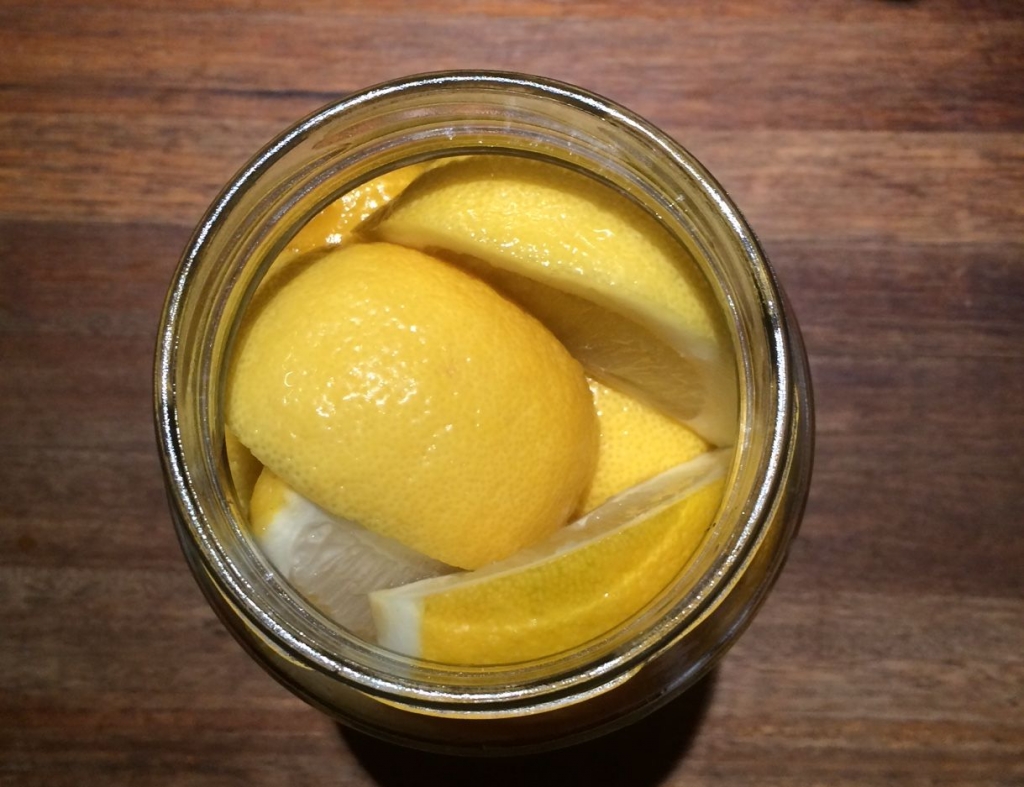
Lemons ready to pickle, colonial style Photo © Jacqui Newling
A cut above
Another characteristic of the Moroccan-style lemons we make today is the way they are cut, quartered from the top down, but not cutting them right through. Pearson’s recipes has us cutting the lemons into quarters, which might be seen as a ‘cheating’; it is certainly makes for easier handling salting.
Even in the 1880s, preserving lemons was far from a new trend. A quick ‘audit’ of the stash of period cookbooks on my desk show pickled lemons recipes in Mrs Beeton’s Book of household management from 1861, Eliza Acton’s Modern cookery, from 1845, Maria Rundell’s Domestic cookery in 1816, Elizabeth Raffald’s Experienced Housekeeper from 1769 and Elizabeth Smith’s The Compleat Housewife from 1753. All use vinegar – those that specify all say to use white wine vinegar – but interestingly, with the exception of Rundell, who cuts them into eighths, each is faithful to the partial cutting method. Eliza Acton describes the process best, ‘
‘make, at equal distances, four deep incisions in each, from the stalk to the blossom end, but without dividing the fruit; stuff them with as much salt as they will contain, lay them into a deep dish, and place them in a sunny window, or in some warm place for a week or ten days…’
Interestingly, Beeton and Raffald remove the peel from the lemons before salting them, and even more curiously, Smith says to ‘scrape them with a piece of broken glass’ before cutting them open to receive the salt.
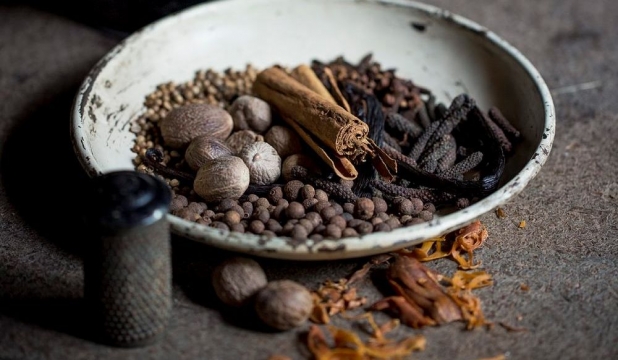
Spice selection Photo © James Horan for Sydney Living Museums. Eat your history, stories and recipes from Australian kitchens, SLM and NewSouth Publishing 2015
The spice trail
The spices used vary a little, although most include cloves, garlic, pepper, mace and/or nutmeg and mustard seed, which is consistent with Mrs Pearson’s version. Some also ask for cayenne or ‘red Indian pepper’ (chilli), and Acton’s also says to use ginger and turmeric. In her ‘Obs.‘ (observations) note below her recipe she says that ‘the turmeric and garlic may, we think, be omitted from this pickle with advantage‘. Some recipes use ground spices, others whole, or ‘bruised’ and tied in a muslin bag. The origins of the salting technique are not given – garlic, chilli, ginger and mustard but especially turmeric suggest India, which is known for its spiced lime pickle; lemons may be an English adaptation. Alternatively, the technique could have North African origins, and have come into England via Spain or Portugal, which are known for their use of vinegar in ‘sauce piquante’ and Goan Vindaloo curries (vin being the characterising vinegar element), for example, and again, returns us to India as an influence.
None of the recipes say how the pickle should be used; one assumes it was used in place of fresh lemon when they were out of season. Mrs Beeton gives the good suggestion of using the liquor ‘strained and bottled, and will be found an excellent lemon ketchup‘. Given the pep that chilli vinegar brings to all manner of savoury dishes – rice and chicken in particular, the pickled lemon vinegar ‘liquor’ would be a similarly welcome condiment.
Pickled Lemons
Ingredients
- 6 lemons
- 4 tablespoons pure sea salt (eg granulated cooking salt, with no free-flow additives)
- 1/2 teaspoon cloves, ground (or to taste)
- 15g mace, ground
- 60g mustard seeds, lightly crushed
- 1 nutmeg, sliced or coarsely grated
- 30g garlic, or shallot
- 1l vinegar
Note
This recipe is based on Margaret Pearson, Cookery Recipes for the People (Melbourne: Hutchinson, 1888), reproduced in The Colonial Kitchen by Charmaine O'Brien (Rowman & Littlefield, 2016). Once pickled, the lemons need to be left to mature and soften for a month or so before eating.
Typical of many period recipes, cloves were not included in the original ingredients list, so use these according to your taste. Ground spices give a cloudy effect, so use whole spices if preferred. It is unusual these days to slice nutmegs; grating coarsely should be adequate, or use whole blades of mace in its place.
Directions
If using store-bought lemons, scald them with boiling water before using them, to remove any wax.
Cut the lemons lengthways into quarters, removing the seeds. Put the lemon quarters into a sterile heatproof jar that fits them quite snugly. Sprinkle with salt, cover and let stand for three days. Add the spices and garlic or shallot. Boil the vinegar, pour it over the spiced lemons, and seal while hot. Store for a week or more before using.
COOK'S TIP: for more convenient use, divide the spiced lemons, and any juice that has been extracted, between smaller jars before pouring over the vinegar. You may need to use more vinegar for this option.
Pickled Lemons
Ingredients
- 6 lemons
- 4 tablespoons pure sea salt (eg granulated cooking salt, with no free-flow additives)
- 1/2 teaspoon cloves, ground (or to taste)
- 15g mace, ground
- 60g mustard seeds, lightly crushed
- 1 nutmeg, sliced or coarsely grated
- 30g garlic, or shallot
- 1l vinegar
Note
This recipe is based on Margaret Pearson, Cookery Recipes for the People (Melbourne: Hutchinson, 1888), reproduced in The Colonial Kitchen by Charmaine O'Brien (Rowman & Littlefield, 2016). Once pickled, the lemons need to be left to mature and soften for a month or so before eating.
Typical of many period recipes, cloves were not included in the original ingredients list, so use these according to your taste. Ground spices give a cloudy effect, so use whole spices if preferred. It is unusual these days to slice nutmegs; grating coarsely should be adequate, or use whole blades of mace in its place.
Directions
| If using store-bought lemons, scald them with boiling water before using them, to remove any wax. Cut the lemons lengthways into quarters, removing the seeds. Put the lemon quarters into a sterile heatproof jar that fits them quite snugly. Sprinkle with salt, cover and let stand for three days. Add the spices and garlic or shallot. Boil the vinegar, pour it over the spiced lemons, and seal while hot. Store for a week or more before using. | |
| COOK'S TIP: for more convenient use, divide the spiced lemons, and any juice that has been extracted, between smaller jars before pouring over the vinegar. You may need to use more vinegar for this option. | |
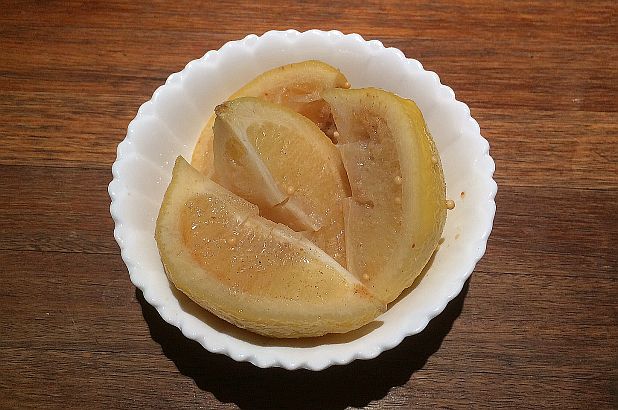
 Print recipe
Print recipe